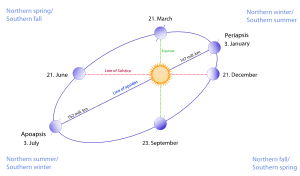Earth's translation

The Earth's translation is the movement of this planet around the Sun, which is the central star of the solar system. The Earth describes an elliptical orbit around it.
If the specific position of a star is taken as a reference, the Earth makes a complete revolution in a sidereal year, whose duration is 365 days, 6 hours, 9 minutes, 9 seconds and 733 milliseconds.
The sidereal year is of little practical importance. For terrestrial activities, measuring time according to the seasons is more important.

The orbit has a perimeter of 940 million kilometers, with an average distance to the Sun of 149,597,870 km, a distance known as an astronomical unit (U.A.). From this it follows that the Earth moves in outer space at an average speed of 107,227 km/h, or 29.8 km/s, in the plane of the ecliptic. (Because the orbit is elliptical and not circular, the speed is not constant, it ranges between 30.3 km/s maximum speed at perihelion and 29.3 km/s minimum speed at aphelion)
Aphelion and perihelion
The elliptical orbital translation generates at some point that the Earth is in the place of the farthest orbit from the Sun, called aphelion, an event that happens in July. At that point the distance to the Sun is 152,098,232 km. Similarly, the point in the orbit closest to the Sun is called perihelion, located 147,098,290 km away. It happens in the month of January.
"The seasonal behavior of the climate is influenced mainly by the inclination of 23.44 degrees of the axis of rotation of our planet with the plane of its orbit, and not by its elliptical orbit,"
During the northern hemisphere winter, the North Pole is pointing away from the Sun. The days are shorter and this makes it colder. Being a little closer to the Sun doesn't matter much.
The seasons are opposite in the southern hemisphere. When the North Pole is tilted pointing away from the Sun, the South Pole points towards an area more direct to it. As a result, summer is in full swing south of the equator.
Some characteristics of the orbit
Orbit drawings can lead to confusion. To make things clearer, the orbit is represented as an ellipse of great eccentricity. But in reality, the maximum variation in the distance to the center is 1.39%, which between the longest and shortest axes, in a 10cm drawing, means a difference of only 0.14mm: imperceptible by the human eye.
The Earth annually describes an elliptical path around the Sun called an orbit. For an observer located in space above the Earth's north pole, this movement is left-handed (counterclockwise). The time it takes for the Earth to complete its "journey" around the Sun is approximately 365 days and 6 hours, a chronological period which we precisely call a year. Our planet describes an elliptical path of 930 million kilometers, at an average distance from the Sun of 150 million kilometers. The Sun is at one of the focuses of the ellipse.
The variants by which this terrestrial movement can be measured and noted are:
- Tropic year or solar year. It is the duration of a complete return to your orbit, which is 365,242198 average solar days: 365 days, 5 hours, 48 minutes and 46 seconds. In this measurement a meridian is taken as a reference that the Earth opposes the Sun twice consecutively.
- Sidereal year. It is the time spent on Earth to pass through a single point of its orbit, taking as reference to the stars. Usually used by astronomers, it is the most exact measure of a year. Its duration is 366,256436918716 Side days. Equivalent to 365,256363 average solar days: 365 days, 6 hours, 9 minutes and 10 seconds.
In ancient times it was believed that the entire solar system revolved around the Earth (geocentric theory), until Nicholas Copernicus proposed the heliocentric theory, which only explains that the solar system does not revolve around the Earth (it is the one that is currently used).
Consequences of translational movement
The inclination of the Earth's axis of rotation also promotes the succession of the seasons. Seasonal changes are more pronounced in the middle latitudes. They are always complementary (opposite) in the two hemispheres of the Earth. So, for example, when it is winter in the northern hemisphere, it is summer in the southern hemisphere, and vice versa. These contrasts are not due to the fact that the Earth is more or less far from the Sun, but rather that throughout the year the translation of our planet causes the solar rays to reach each hemisphere with a different axial inclination (or obliquity of the ecliptic) depending on the time of year.
Currently, perihelion occurs around January 3, and aphelion around July 4. The varying distance between the Earth and the Sun results in an approximately 6.9% increase in solar energy reaching the Earth at perihelion compared to aphelion. Because the Southern Hemisphere is tilted toward the Sun at about the same time that the Earth reaches its closest point to the Sun, the Southern Hemisphere receives slightly more energy from the Sun than the Northern Hemisphere throughout the year. However, this effect is much less important than the total change in energy due to the tilt of the axis of rotation, and almost all of the excess energy is absorbed by the greater proportion of water in the southern hemisphere.
Thermal zones, warm/intertropical zone is the central part of the earth, where the equator passes; temperate zone, from the tropic of cancer to the arctic circle and from the tropic of capricorn to the antarctic circle; cold zone are the two poles.
Different length of days and nights in different parts of the globe.
Contenido relacionado
Triton (satellite)
Nicolaus Copernicus
Carl Wilhelm Wirtz
Hubble–Lemaître law
Stephen Hawking